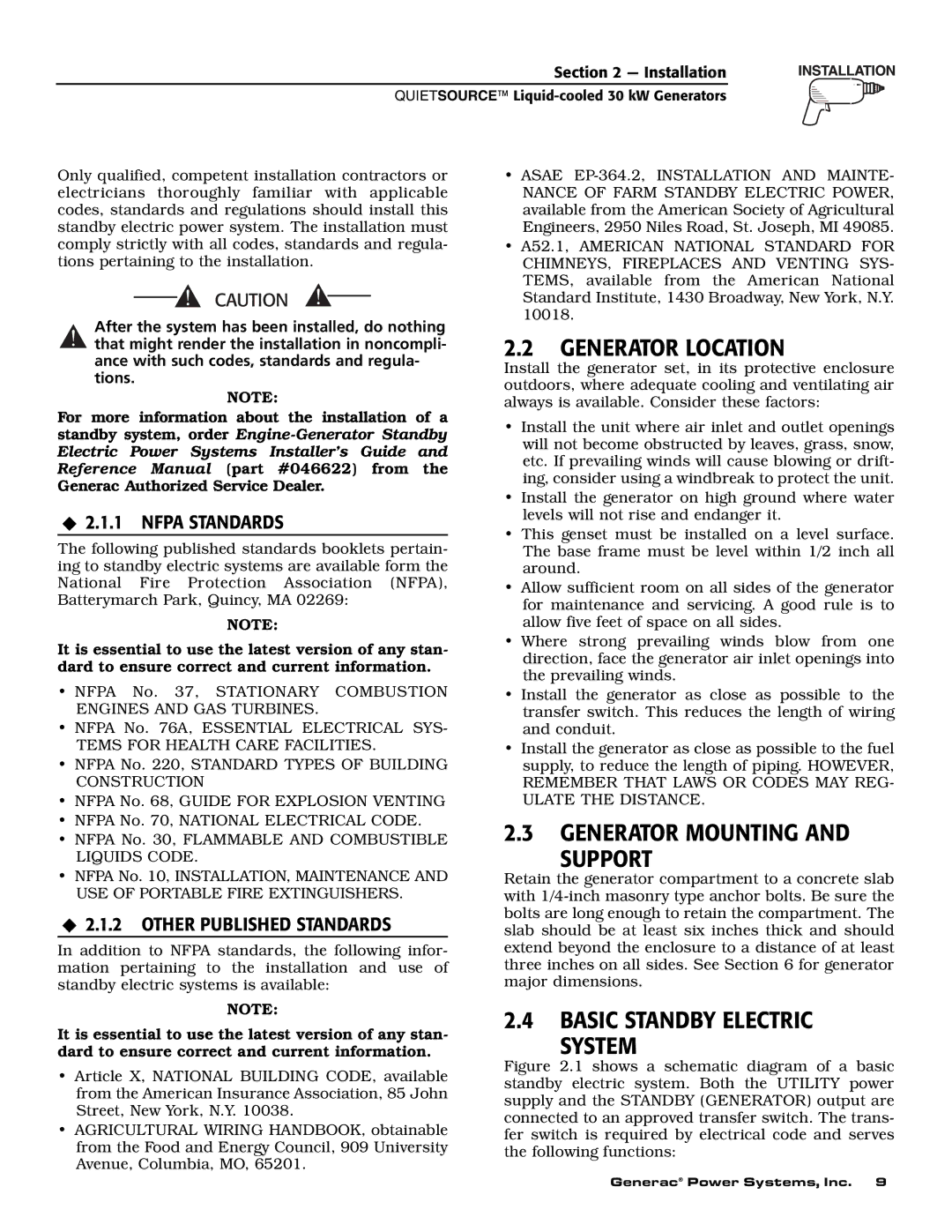
Section 2 — Installation
QUIETSOURCE™
Only qualified, competent installation contractors or electricians thoroughly familiar with applicable codes, standards and regulations should install this standby electric power system. The installation must comply strictly with all codes, standards and regula- tions pertaining to the installation.
After the system has been installed, do nothing ! that might render the installation in noncompli-
ance with such codes, standards and regula- tions.
NOTE:
For more information about the installation of a standby system, order
2.1.1 NFPA STANDARDS
The following published standards booklets pertain- ing to standby electric systems are available form the National Fire Protection Association (NFPA), Batterymarch Park, Quincy, MA 02269:
NOTE:
It is essential to use the latest version of any stan- dard to ensure correct and current information.
•NFPA No. 37, STATIONARY COMBUSTION ENGINES AND GAS TURBINES.
•NFPA No. 76A, ESSENTIAL ELECTRICAL SYS-
TEMS FOR HEALTH CARE FACILITIES.
•NFPA No. 220, STANDARD TYPES OF BUILDING CONSTRUCTION
•NFPA No. 68, GUIDE FOR EXPLOSION VENTING
•NFPA No. 70, NATIONAL ELECTRICAL CODE.
•NFPA No. 30, FLAMMABLE AND COMBUSTIBLE LIQUIDS CODE.
•NFPA No. 10, INSTALLATION, MAINTENANCE AND USE OF PORTABLE FIRE EXTINGUISHERS.
2.1.2 OTHER PUBLISHED STANDARDS
In addition to NFPA standards, the following infor- mation pertaining to the installation and use of standby electric systems is available:
NOTE:
It is essential to use the latest version of any stan- dard to ensure correct and current information.
•Article X, NATIONAL BUILDING CODE, available from the American Insurance Association, 85 John Street, New York, N.Y. 10038.
•AGRICULTURAL WIRING HANDBOOK, obtainable from the Food and Energy Council, 909 University Avenue, Columbia, MO, 65201.
•ASAE EP-364.2, INSTALLATION AND MAINTE-
NANCE OF FARM STANDBY ELECTRIC POWER, available from the American Society of Agricultural Engineers, 2950 Niles Road, St. Joseph, MI 49085.
•A52.1, AMERICAN NATIONAL STANDARD FOR CHIMNEYS, FIREPLACES AND VENTING SYS- TEMS, available from the American National Standard Institute, 1430 Broadway, New York, N.Y. 10018.
2.2GENERATOR LOCATION
Install the generator set, in its protective enclosure outdoors, where adequate cooling and ventilating air always is available. Consider these factors:
•Install the unit where air inlet and outlet openings will not become obstructed by leaves, grass, snow, etc. If prevailing winds will cause blowing or drift- ing, consider using a windbreak to protect the unit.
•Install the generator on high ground where water levels will not rise and endanger it.
•This genset must be installed on a level surface. The base frame must be level within 1/2 inch all around.
•Allow sufficient room on all sides of the generator for maintenance and servicing. A good rule is to allow five feet of space on all sides.
•Where strong prevailing winds blow from one direction, face the generator air inlet openings into the prevailing winds.
•Install the generator as close as possible to the transfer switch. This reduces the length of wiring and conduit.
•Install the generator as close as possible to the fuel supply, to reduce the length of piping. HOWEVER, REMEMBER THAT LAWS OR CODES MAY REG- ULATE THE DISTANCE.
2.3GENERATOR MOUNTING AND
SUPPORT
Retain the generator compartment to a concrete slab with
2.4BASIC STANDBY ELECTRIC
SYSTEM
Figure 2.1 shows a schematic diagram of a basic standby electric system. Both the UTILITY power supply and the STANDBY (GENERATOR) output are connected to an approved transfer switch. The trans- fer switch is required by electrical code and serves the following functions:
Generac® Power Systems, Inc. 9
